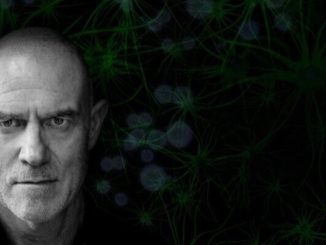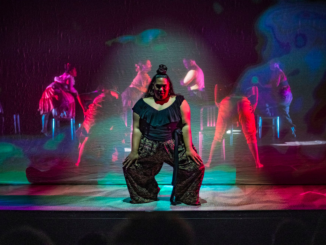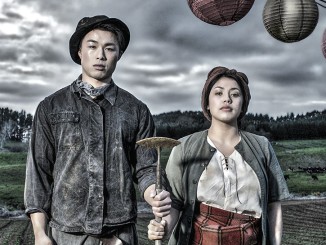
The first part of Whenua closes with the voice of celebrated choreographer Rodney Bell (Ngāti Maniapoto), his words projected in red across a slanting white screen — “Ko au ko koe, ko koe ko au”: I am you, and you are me.
Connections to one another and to the land are central themes of this striking double-bill from the New Zealand Dance Company. The show, which won acclaim on its European tour earlier this year, comprises “Imprint”, choreographed by Bell and Malia Johnston; and “Uku — Behind the Canvas”, choreographed by Eddie Elliott (Ngāti Maniapoto). The creative vision underpinning these thrillingly different pieces shines through in both the production’s technical aspects and its tremendously gifted performers (Katie Rudd, Brydie Colquhoun (Ngāti Kawa, Ngāpuhi), Bianca Hyslop (Ngāti Whakaue), ‘Isope ‘Akau’ola (Utulau, Lotofoa; Tonga), Kosta Bogoievski, and Jeremy Beck (Ngāi Tahu/Kai Tahu)).
Whenua is an engrossing experience, rooted in Te Ao Māori and combining traditional and modern styles of dance in an innovative yet accessible way.
We are guided into “Imprint” by a series of embraces. The dancers move among one another, wrapping their arms around each member of the company in turn; holding the shape of that embrace after it has ended. Right away we’re introduced to the heart of the work — the indelible impressions people leave on other people and their surroundings, and which our surroundings leave on us. The performers display an impressive fluidity and control, added to at times by a mesmerising weightlessness. There’s both a sharpness and grace to their movements as “Imprint” cycles through what might be called various ‘phases’. Each one places a single dancer centerstage, allowing them to show off their talents before returning again to the collective.
These phases are heralded by brief soundbites, largely of Bell’s voice, and a musical transition. Eden Mulholland’s compositions include calming nature-inspired sounds, choral arrangements, and rhythmic contemporary beats. From the soothing to the staccato, the music traces the journey of the dancers through the piece. Rowan Pierce’s AV, spatial and lighting design is similarly expressive. Slower sequences often feature a sort of smoky lighting from above and either side of the stage, while a row of bulbs at the back flash on and off brightly during the more frenetic moments. A recurring technique is the use of a spotlight at one end of the space, which the dancers lean into as if listening for something. I particularly enjoyed the moment when two dancers swirled together behind the rectangular white screen in the middle of the stage, their shadows blurred and multiplied; reminiscent again of Bell’s words: I am you, and you are me.
The screen plays a more prominent role than I’d initially expected, raising and lowering at different points in the piece. So, too, does the white cloth laid out onstage almost ceremonially at the start. It transforms satisfyingly from something the dancers dance on to something they dance with, later being gathered up beneath their feet and draped across their shoulders. It’s appropriate that the set should be integrated into the performance in this way; linked together just as body and land are linked.
“Uku — Behind the Canvas” is a different beast, and feels like the true headliner of Whenua. If the word I would use to summarise “Imprint” is flow, “Uku” radiates power. The heightened drama of this work is conveyed by a darker, starker stage than what we saw in “Imprint”, with no screen and instead a backdrop resembling, quite aptly, a canvas. Rona Ngahuia Osborne’s set design is complemented by Jo Kilgour’s lighting: a great deal of the piece takes place in and around shadows. All of this invests “Uku” with a suitably mythic quality. Drawing on the Māori creation story of Hineahuone, the first woman molded from the earth by Tāne, it opens with the dancers crouched in a line at the front of the stage like creatures not yet made. Through strength and struggle, they pull themselves up, or are pulled up by others.
There’s a solidity to the dancers’ movements throughout that reflects the raw, explosive nature of this work. Exploring internal and external conflict and the place of tangata whenua, it’s the wāhine posing the question: “Is this my land?” I felt a greater sense of the narrative ‘arc’ of this piece, and was intrigued to find the storytelling done through the dancers’ voices as well as their bodies. “Uku” replaces their soft exhales and exclamations in “Imprint” with a full-blown vocal performance, involving waiata (“Tai Aroha”) and haka. Eddie Elliott’s bold choreography demands attention; as does the music created with Jason Wright and Alistair Deverick, which functions as an effective, often ominous soundscape combining the primordial with the industrial.
Most compelling is the use of clay, with the performers smearing it on themselves, one another, and the stage. An obvious reference to the earth out of which Hineahuone was formed, the clay shows clearly on their dark costuming (also by Osborne), enabling them to literally wear that story on their bodies. The streaks of clay also tell the story of the physical space, marking where each dancer has been like a map. It’s a map that grows more complex as the piece builds in intensity along with the dancers’ movements. At times they’re locked together; at others, they break apart violently. When that tension is released partway through the work, we’re treated to a playful metatheatrical interlude, involving the wāhine passing commentary on the tāne. That interlude acts as a surprising turning point, with the emotions ramping up even more strongly than before. Yet despite its rage, or perhaps because of it, “Uku” ends on a quieter note — a dimming stage and a dancer’s address to Papatūānuku, confirming: “This is my home”.
Whenua played the Q theatre the 10-11th of April 2024




Leave a Reply